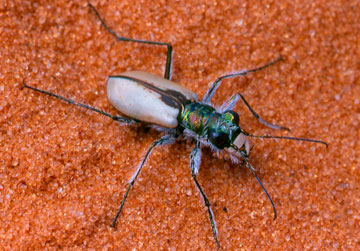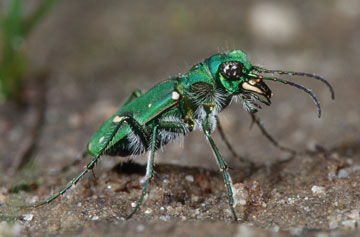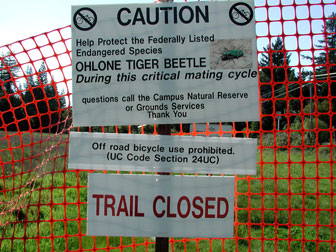Conservation biology needs to be accessible to the masses
Conservation biology needs to be accessible to the masses
Are we doomed to repeat our mistakes in Conservation Biology?
mongabay.com
May 31, 2007
Since its earliest days, when private collectors amassed great stores of specimens collected from the farthest reaches of the Earth, natural history studies often have been a pursuit of the economically well-off and of intellectually elitist scientists. One of the most important spinoffs of these natural history studies has been Conservation Biology. Unfortunately, the culture of exclusivity appears to have also infected Conservation Biology. Technical jargon, restricted access to data, and poor communication among researchers, amateur enthusiasts and political decision-makers have colluded to keep it a clubby affair that may be hurting goals of sustainable use of resources, long term management policies, and species and habitat conservation.
Now, in a paper published in The Journal of Insect Conservation, Arizona State University biologist David L. Pearson and his lawyer co-author, Fabio Cassola, argue that Conservation Biology doesn’t have to be this way. They say making the science more accessible to the masses will enhance public support for conservation initiatives and accelerate the accumulation of information about the world around us.
In May 2007 Pearson discussed his paper and how it applies to the future of biodiversity conservation.
Rhett A Butler (Mongabay): How can studying the history of science improve future conservation efforts?

Coral Pink Sand Dunes Tiger Beetle, a species that is found on less than a |
Pearson: The saying, “Those who cannot learn from history are doomed to repeat it,” is usually considered a catchy but trivial turn of words. However, some scientists, especially in Conservation Biology, feel that these words might hold more profound significance and actually be a testable scientific hypothesis. If so, this saying might help us anticipate problems, plan for conservation efforts, and influence policy decisions in the future.
Putting up with opposition from many historians, who insist history should only report past events, and from numerous scientists, who say that history is not a scientific endeavor, we decided to test the “doomed” hypothesis and see if it might be a useful tool for developing Conservation Biology research and policy. As a first step, we searched for patterns within the history of scientific studies, including fields ranging from physics to biology. Are there identifiable steps in the way scientists study their fields no matter what the subject matter? If so, what causes these changes to take place in the way they do? How can completely different fields of science best be compared? Apart from satisfying intellectual curiosity, a solid understanding of patterns in the development of science could prove useful for Conservation Biology in many ways.
It could: (1) help shape priorities for funding agencies, (2) enable biologists to better communicate with non-scientific decision makers, (3) focus individual researcher goals, (4) prepare cooperative research agendas, (5) devise more reliable and efficient models for management and conservation goals, and (6) help anticipate problems that can then be avoided.
(Mongabay): How would you test for consistency over the history of science?
Pearson: One of the most reliable techniques for answering historical questions and testing for patterns is by using insights from one field to tell us something about another – a process called consilience by historians. With this method, hopefully we can make sense of the past and perhaps anticipate the future.
One general model of the history of science that claims to anticipate historical patterns in biology is the General Continuum of Scientific Perspectives on Nature (GCSPN) developed by Killingsworth and Palmer in 1992. According to the GCSPN, earliest biological studies begin with natural history and concentrate on observations in the field and specimen collecting, followed by observing and measuring in the field, manipulations in the field, observations and manipulations in the laboratory, and finally enter theoretical science, including systems analysis and mathematical models. In 1998, Battalio took this model and created a list of specific characters that would serve as a test of consistent steps within the GCSPN model:
- (STEP 1) Descriptive natural history and search for new species predominate
- (STEP 2) Now an experimental science rather than a natural history model
- (STEP 3) Power is transferred from expert amateurs to trained professional scientists, and graduate training for employment in the field has become available
- (STEP 4) Systematics no longer dominant, and research focused more on theoretically complex issues with extensive use of graphs and statistical inference in publications
- (STEP 5) Formation of research teams and increasing evidence of socialization, such as use of acknowledgments sections, associations of peers, and co-authored publications
- (STEP 6) Technical terminology and methodology so refined they now limit the audience that can fully comprehend them.
(Mongabay): Why did you use tiger beetles as a test organism?

Ohlone Tiger Beetle, a species confined to 9 small remnant patches of coastal grassland in Santa Cruz County, California, and listed by US Fish and Wildlife Service as an endangered species. Photo by K. Fielding. |
Pearson: To determine the usefulness of the historical model for predicting the future of Conservation Biology studies, we needed a representative study organism, a “white rat” if you will. Studies of Conservation Biology involving tiger beetles have become increasingly common in the last fifteen years. Governments and NGOs in several countries have considered tiger beetles in making policy decisions of national conservation efforts and have found tiger beetles useful organisms for arguing broad conservation issues. Thus, using a balance of historical and analytical approaches, we tested the model using scientific studies of these beetles.
(Mongabay): What did the beetles tell you?
Pearson: Our analysis showed that the history of tiger beetle studies closely followed the historical model and its predicted steps. These historical studies of tiger beetle also warned us that the procession of steps, when applied to Conservation Biology, eventually could make many conservation efforts difficult if not impossible to carry out.
As studies advance to steps 5 and 6, they make the data more reliable, but they also simultaneously exclude more and more non-scientists. The jargon, data analysis, and technical skills needed to critique or even understand the studies in these later steps steadily narrow the audience that can digest the results and use them. This is also an accurate description of where many if not most studies in Conservation Biology are today
Ironically, this is just the time that policy makers in government offices, judges, lawyers, reporters, teachers, and many others need to understand the nuances of rigorous conservation studies. Relying on insight from detailed scientific studies, these non-scientists teach our children, interpret results for the press and broadcast news, make environmental laws and enforce decisions that impact entire nations. But if they cannot understand the data analysis, how can they accurately include the results in their reports and political decisions? If the march of scientific progress is inevitable, it will produce more and more dependable data that are at the same time more and more difficult to understand and use by non-scientists.
(Mongabay): Applying what you found, how can scientists make it easier for the general public to understand and become involved with conservation biology?

Controlled area on University of California-Santa Cruz campus to protect the Ohlone Tiger Beetle breeding area. Photo by UC Santa Cruz Grounds Dept. |
Pearson: If we can learn from history and anticipate problems, we need not be doomed to repeat it. Conservation Biologists can use this knowledge of the past to anticipate and prepare for the future. They can write summaries or popular articles using language and writing styles that maintain accuracy but avoid jargon. They can involve interested amateurs in all levels of their studies to maintain channels of communication. They can seek out the public by providing comprehensible material on web sites, Podcasts, oral presentations and through the media. They can do what ever it takes to make sure that step 6 does not impede the application of conservation studies to laws and guidelines that are understandable and accepted by the public as well as by the decision makers.
Instead of letting the maturity of scientific efforts take a path that diverts it from general comprehension, we can take proactive actions to make sure that non-scientists can grasp the significance of sophisticated results and incorporate them into their policy decisions. Thus the study of history, rather than dooming us, can enlighten and guide us into the future and help Conservation Biology reach all of its goals.
(Mongabay): The Encyclopedia of Life, a Wikipedia-type project that will supposedly contain everything there is to know about all species, seems to have an important caveat: it will only be editable by scientists. Do you think the project, which follows a string of similar projects that never really got off the ground, is diminished by excluding non-scientists?
Pearson: I don’t know all the details of the project, but I do know that unless it is opened up to many Pro-Ams (professional amateurs), it can’t possibly have the breadth and depth that are likely needed for success. As in many other taxa, field studies of distribution, declining populations, and descriptions of new species of tiger beetles have been taken over almost completely by amateurs. Professionals dominate more technical fields of spatial modeling, molecular studies, physiological adaptations, and conservation policy. The field of tiger beetle studies cannot advance without the continued basic studies carried out primarily by amateurs. The professionals need a constant source of these very basic data to apply their sophisticated techniques and analyses.
Using a broader but parallel insight, in 2004, the British social critics, Charles Leadbeater and Paul Miller wrote a very interesting book on this subject. They identified a rapidly growing involvement of amateurs in science from astronomy to medicine that is not fully recognized or utilized by professionals. These amateur investigators are a new breed of largely self-trained experts or professional amateurs (Pro-Ams) who, using modern technology, such as the Internet, are producing significant innovations and discoveries in a wide range of fields. Leadbeater and Miller propose that the government and professionals need to facilitate the contributions of Pro-Ams and be prepared to share the stage with them so that there can be mutually beneficial advances in their shared field. Conservation Biology should do no less.
For more details read:
- Battalio, J. T. 1998. The rhetoric of science in the evolution of American ornithological phases. ATTW Contemporary Studies in Technical Communication, vol. 8. Ablex Publishing Corporation, Stamford, Connecticut.
- Killingsworth, M. J., and J. S. Palmer. 1992. Ecospeak: Rhetoric and environmental politics in America. Southern Illinois University Press, Carbondale, Illinois.
- Leadbeater, C. and P. Miller. 2004. The Pro-Am Revolution: How Enthusiasts are Changing our Economy and Society. Demos Publ., London, UK.
- Pearson, D. L. and F. Cassola. 2007. Are we doomed to repeat history?: A model of the past using tiger beetles (Coleoptera: Cicindelidae) and conservation biology to anticipate the future. Journal of Insect Conservation 11: 47-59.














